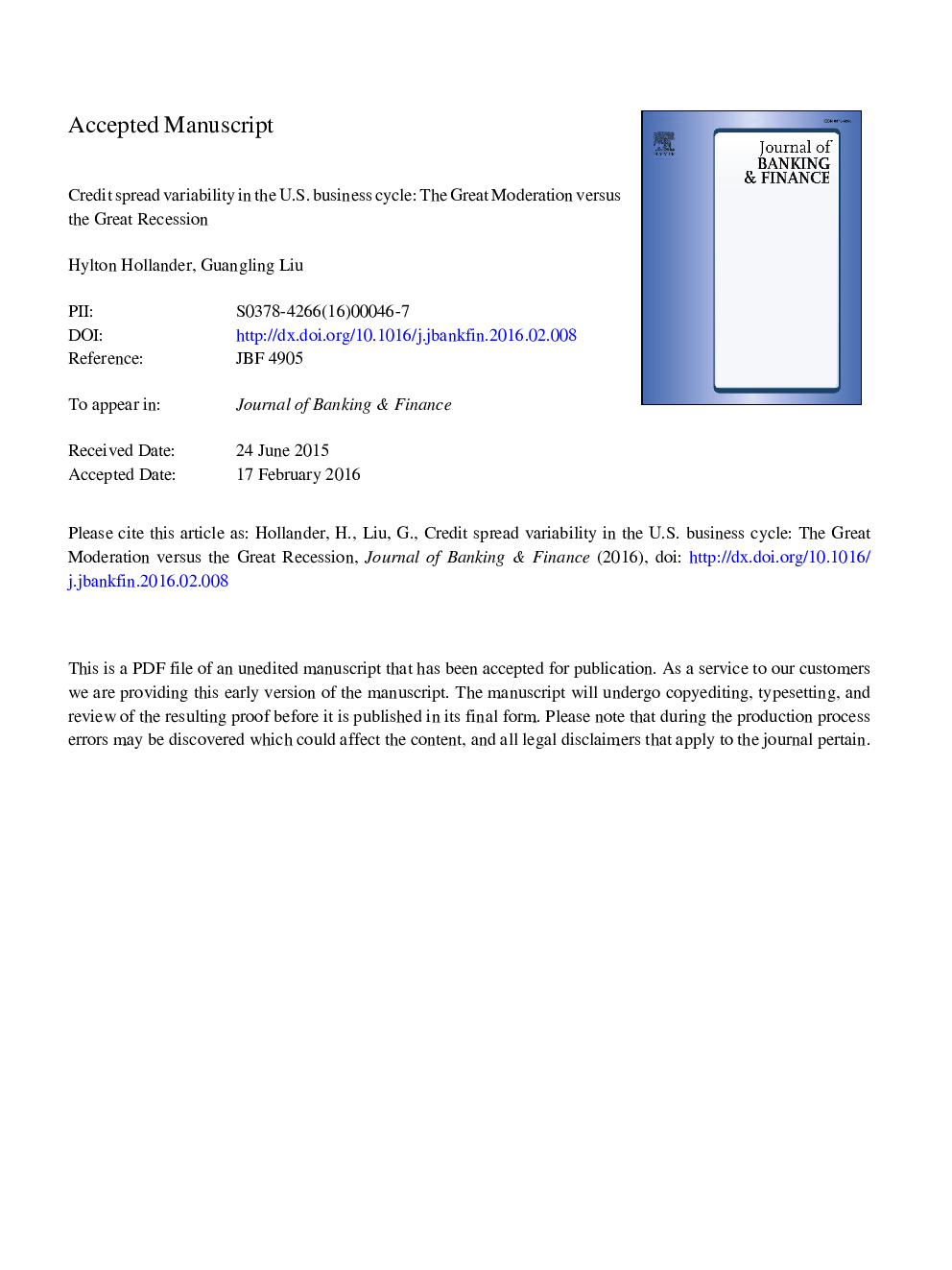| کد مقاله | کد نشریه | سال انتشار | مقاله انگلیسی | نسخه تمام متن |
|---|---|---|---|---|
| 5088387 | 1478308 | 2016 | 64 صفحه PDF | دانلود رایگان |
عنوان انگلیسی مقاله ISI
Credit spread variability in the U.S. business cycle: The Great Moderation versus the Great Recession
ترجمه فارسی عنوان
متغیر اعتبار گسترش در چرخه کسب و کار ایالات متحده: مدرن بزرگ در برابر رکود بزرگ
دانلود مقاله + سفارش ترجمه
دانلود مقاله ISI انگلیسی
رایگان برای ایرانیان
کلمات کلیدی
ترجمه چکیده
این مقاله عوامل فزاینده ای را که بر متغیر اعتبار گسترش تاثیر می گذارند شناسایی می کند و نشان می دهد که چگونه بر چرخه کسب و کار ایالات متحده در طی رکودهای 1990-91 و 2001 دوره مدرن بزرگ (1984-2006) و رکود بزرگ 2007-09 تأثیر گذاشت. برای انجام این کار، ما یک مدل تعادل عمومی پویای را توسعه داده و تخمین می زنیم که در آن واسطه مالی و دارایی های سهام نقش مهمی ایفا می کنند. در طی سه دوره رکود اقتصادی، ما دریافتیم که قدرت بازار بانکی (تنظیم نرخ چسبنده و نشانه های نرخ بهره) نقش مهمی در تغییر متغیر اعتباری ایفا می کند که چرخه کسب و کار ایالات متحده را مختل می کند. قیمت های سهام تشدید حرکت در گسترش اعتبار را از طریق کانال شتاب دهنده مالی تشدید می کند، اما نمی تواند به عنوان یکی از عوامل اصلی حرکت متغیر اعتبار در نظر گرفته شود. در سه دوره، کاهش قابل ملاحظه ای در تأثیر تکنیک ها و شوک های سیاست پولی مشاهده می شود. تاثیر شوکهای نسبت به نسبت ارزش به وام پس از رکود اقتصادی در سالهای 1990-1991 کاهش یافت، در حالی که شوک ضروری سرمایه بانکی و تغییر متغیر اعتبار طولانی مدت نسبت به رکود 2007-09 افزایش یافت.
موضوعات مرتبط
علوم انسانی و اجتماعی
اقتصاد، اقتصادسنجی و امور مالی
اقتصاد و اقتصادسنجی
چکیده انگلیسی
This paper identifies the prevailing financial factors that influence credit spread variability and shows how they affected the U.S. business cycle during the 1990-91 and 2001 recessions of the Great Moderation period (1984-2006) and the Great Recession of 2007-09. To do this, we develop and estimate a dynamic general equilibrium model in which financial intermediation and equity assets play a central role. Over the three recession periods, we find that bank market power (sticky rate adjustments and loan rate markups) played a significant role in the credit spread variability that disrupted the U.S. business cycle. Equity prices exacerbate movements in credit spreads through the financial accelerator channel, but cannot be regarded as one of the main driving forces of credit spread variability. Across the three periods, we observe a remarkable decline in the influence of technology and monetary policy shocks. The influence of loan-to-value ratio shocks declined after the 1990-91 recession, while the bank capital requirement shock exacerbated and prolonged credit spread variability over the 2007-09 recession.
ناشر
Database: Elsevier - ScienceDirect (ساینس دایرکت)
Journal: Journal of Banking & Finance - Volume 67, June 2016, Pages 37-52
Journal: Journal of Banking & Finance - Volume 67, June 2016, Pages 37-52
نویسندگان
Hylton Hollander, Guangling Liu,
